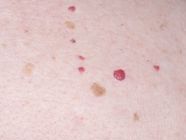A foot corn is a thick, hardened area of skin that forms due to repeated friction or pressure on the toes or the sole of the foot. It is often painful. Some common causes of foot corns include tight shoes, standing for long periods, and wearing shoes or sandals without socks. Learn how to treat foot corns. (1)
Treatment for Foot Corns
Most foot corns gradually disappear when the friction or pressure causing them is eliminated. However, if you have a persistent or extremely painful corn, it is best to consult a dermatologist. There are several treatment options for foot corns, and the
optimal method depends on the size and severity of the corn: (2)
1. Home Treatments
Do not try to cut or remove corns yourself; instead, follow these dermatologist-recommended tips: (3) (4)
- Soak the corn in warm water for 5-10 minutes or until the skin softens.
- Gently file the corn with a pumice stone after soaking it in warm water to remove dead skin, but be careful to avoid injuring healthy skin.
- Apply a medicated moisturizer to the area daily, preferably one that contains salicylic acid or urea, to gradually soften the corn.
- Wear soft insoles or heel pads in your shoes, or opt for thick socks.
- Ensure to:
- Wear comfortable shoes that are not too tight or loose, and avoid high heels or tight pointed shoes. Shop for shoes at the end of the day, not the beginning.
- Avoid walking long distances or standing for extended periods.
- Do not walk barefoot.
- Trim your toenails regularly.
2. Medical Treatments
If the corn persists or becomes painful despite following self-care measures, medical treatments can provide relief: (2)
- Topical Medications (Patches or Creams): These are applied to the corn and contain chemicals that help soften the dead skin and make it easier to remove, such as salicylic acid and urea.
- Trimming and Removal of Excess Skin: This is done in a doctor's office using a surgical scalpel.
- Laser Treatment: Laser therapy may be used to remove the superficial layers of the affected skin.
Here is the complete and revised translation with all parts covered:
When to See a Doctor?
In most cases, simple foot corns can be treated at home using the aforementioned home remedies. However, if you do not notice any improvement, it is advisable to consult a doctor. You should also see a doctor if: (5)
- Severe pain interferes with your daily activities.
- The area around the corn becomes inflamed, red, or swollen.
- Bleeding occurs.
- The corn becomes infected, showing signs such as pus or a foul odor.
- You have diabetes: People with diabetes are at a higher risk for complications like diabetic foot, so they should see a doctor as soon as any foot issues arise.
- You have heart disease or circulation problems.
Suffering from Foot Corns? Our medical team in the Dermatology Department at Al-Ahli Hospital offers comprehensive services for treating foot corns, starting from accurate diagnosis to preventive advice and treatments. Contact us now to schedule an appointment.
References:
- Corns and calluses, Mayo Clinic
- Understanding Corns and Calluses -- Diagnosis and Treatment, WebMD
- How to treat corns and calluses, American Academy of Dermatology Association
- Corns and calluses, NHS
- Corns and Calluses: Symptoms, Causes & Treatments, Cleveland Clinic






